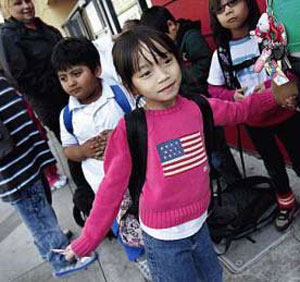
Long recognized for its Latino population, recent census figures indicate California is also home to a burgeoning Asian population. According to figures from the U.S. Census Bureau, Asians were the nation’s fastest growing ethnic group from 2000 to 2010, increasing 43 percent. San Francisco has always had a large Asian population, but now, more Asians reside in places like San Jose, the San Gabriel Valley, a suburb east of Los Angeles, and the Santa Ana/Garden Grove area in Orange County, Calif.
“It’s been a trend that has been occurring for some time, and it’s driven by international migration, mainly from China and India, and to a lesser extent the Philippines,” says Hans Johnson, demographer, and senior fellow at the Public Policy Institute of California.
This is no surprise to Joel Kotkin, an expert on global, political, social, and economic trends. Kotkin is also the author of the recent book, “The Next Hundred Million: America in 2050,” and a California resident since 1971.
“The San Gabriel Valley has the largest concentration of Asians in America,” Kotkin says. Like many other ethnic groups, Asians tend to migrate to areas where there are clusters of people who share the same ethnicity. In the San Gabriel Valley, it is common to see stores with signs in Chinese. Kotkin also points out that it is possible to survive with minimal English skills, because so many people are bilingual.
Kotkin added that California has a long history with Asians, who first arrived in the state in the 1880s. California, because of its geographic location, has ties to the Pacific Rim countries. Kotkin says there are several daily flights from California to Asian countries.
Although census takers classify California’s Asian population as one group, it is far from homogenous. The San Gabriel Valley is home to many Vietnamese, Koreans, Filipinos, and Chinese. Kotkin adds that there is also a growing number of South Asians (Indians, Pakistanis, and Bangladeshis.)
 While first-generation Asians, may see themselves in distinct ethnic groups, this changes with their children.
While first-generation Asians, may see themselves in distinct ethnic groups, this changes with their children.
“I think there is kind of pan-Asian thing in the second generation,” Kotkin says. “If you ask a Chinese person what is his ethnicity, he will say Chinese, not Asian, but it’s different in the second generation.”
Second-generation Asians are also very upwardly mobile. Unburdened by language difficulties they often move up the social ladder into professional careers in law, business, and medicine.
Johnson says many South Asian immigrants arrive in America with bachelor’s degrees, and their children graduate from college at higher levels than other American children.
However, Johnson notes that this is not uniform among all Asians. He points out that some Asian groups, such as the Hmong and Laotians, arrive in the United States with low educational skills and have not seen the same pattern of growth.
Kotkin adds that some Asians are moving away from the stereotypical medical and business fields into more artistic ventures. We now see an increasing presence of Asians in fashion and the entertainment industry, such as comedian Dat Phan and hip-hop group Far East Movement.
He says second and third generation Asians such as Edwin M. Lee, mayor of San Francisco are also becoming more politically active and running for office.
